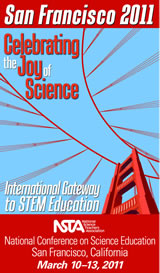Reaching NARST and NSTA Audiences
Project 2061 staff members have taken their expertise on the road to present their work at the annual conferences of the National Science Teachers Association (NSTA) and the National Association for Research in Science Teaching (NARST).
2011 National NSTA Conference
March 10-13, 2011, San Francisco, CA
More than 100 attendees a the NSTA conference joined presenter Ted Willard in three sessions designed to help science educators learn more about different aspects of Project 2061’s current research and development work. A session on “Standards-Based Assessment Items” focused on Project 2061’s approach to science assessment, its assessment development process, and the launch of the new AAAS Science Assessment website. In a session on “Using NOAA and NASA Data to Teach About Weather and Climate,” attendees found out about Project 2061’s efforts to develop online teaching resources, including classroom activities and assessment tools, that are built around earth, ocean, and atmospheric data collected by NOAA and NASA. For science teachers with a special interest in digital resources, a half-day workshop on “An Overview of NSDL’s Science Literacy Maps” introduced participants to the online maps, their relationship to the conceptual strand maps published in the Atlas of Science Literacy, how to use the digital maps to improve their classroom practice, and how to search more effectively for NSDL teaching resources.
* * * * * * * * *
2011 NARST Annual Conference
April 3-6, 2011, Orlando, FL
Investigating Students’ Understanding of Energy Transformation, Energy Transfer, and Conservation of Energy Using Standards-Based Assessment Items
Cari F. Hermann-Abell and George DeBoer
Abstract: Standards-based multiple-choice assessment items were used to study middle school, high school, and university students’ understanding of ideas about energy transformation, energy transfer, and conservation of energy. The data are a result of a field test administered to 9739 middle school students and 5870 high school students in 46 states across the country and 176 students from a public university in the south central region of the U.S. Rasch modeling was used to estimate and compare the students’ abilities and the item difficulties, and distractor analysis was used to investigate the strength of the students’ misconceptions at the different grade levels. Students’ performance at each level was used to examine the progression of understanding of energy from middle school to university. The results indicated a grade-to-grade increase in understanding from sixth grade to university, with two exceptions: there was no significant increase in performance between sixth and seventh grade, and there was no significant increase between ninth and tenth grade. The students had the most difficulty with items aligned to the idea of conservation of energy and, in a number of cases, students had more difficulty applying a general principle to a specific real-world case than they did in recognizing the truth of the principle itself.
Read the full paper. [PDF, 94KB]
Assessing Middle and High School Students’ Understanding of Evolution with Standards-Based Items
Jean C. Flanagan and Jo Ellen Roseman
Abstract: Understanding evolution is essential to science literacy, as it is the foundation for understanding modern biology and contributes to decision making about environmental and health policy issues. While research has shown that most students lack a correct understanding, none of the assessment tools used in this research have been tested on a large scale. A set of standards-based multiple choice items that assess evolution concepts was developed and field tested on 9,419 middle and high school students in 43 states across a broad range of demographics. Common misconceptions were used as the distractors wherever possible. Four key concepts were assessed: similarities and differences between species, a continually changing environment, the mechanism of natural selection, and the common ancestry of life. The overall mean percent correct was 42.3%. High school students (48.1% correct) performed significantly better than middle school students (38.9%). For all students, the idea of common ancestry was significantly harder than the other three ideas. We noted that a subset of the items assessing this concept, which dealt with common ancestry among both similar and different organisms, were especially difficult for students. The misconception that distantly related organisms share no similarities was found to be strong among all students.
Read the full paper. [PDF, 153KB]






